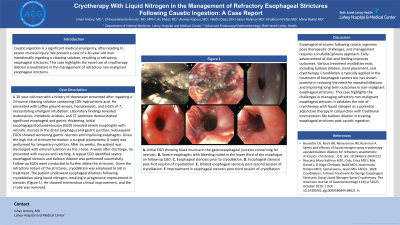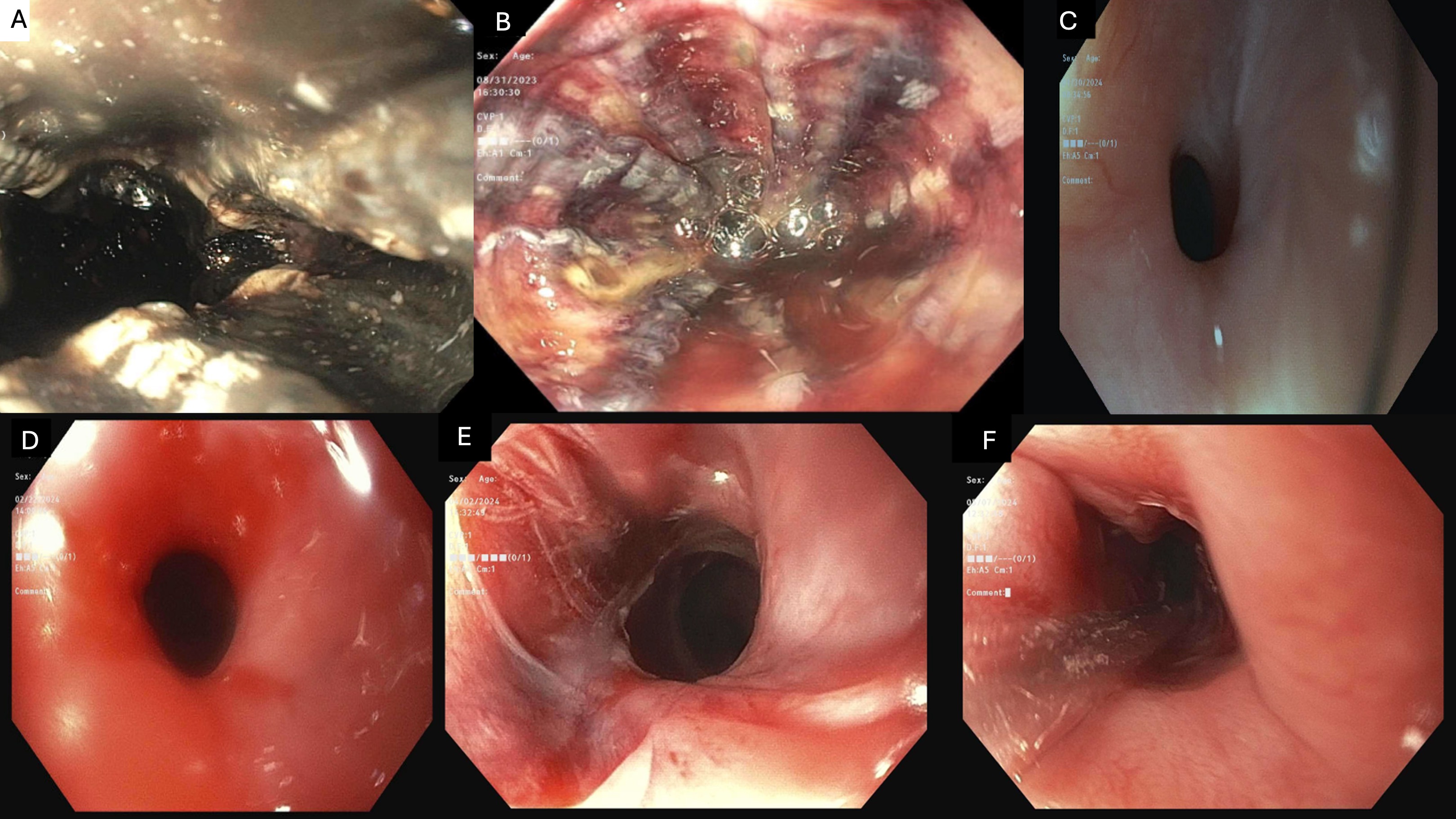Monday Poster Session
Category: Interventional Endoscopy
P2832 - Cryotherapy With Liquid Nitrogen in the Management of Refractory Esophageal Strictures Following Caustic Ingestion: A Case Report
Monday, October 28, 2024
10:30 AM - 4:00 PM ET
Location: Exhibit Hall E

Has Audio

Ishan Antony, MD
Lahey Hospital and Medical Center
Burlington, MA
Presenting Author(s)
Ishan Antony, MD1, Chineye Brenda Amuchi, MD, MPH2, Ali Shaat, MD1, Akshay Kapoor, MD1, Neethi Dasu, DO2, Haider Rahman, MD1, Khaldoon Khirfan, MD2, Mena Bakhit, MD1
1Lahey Hospital and Medical Center, Burlington, MA; 2Beth Israel Lahey Health, Burlington, MA
Introduction: Caustic ingestion is a significant medical emergency, often leading to severe mucosal injury. We present a case of a 30-year-old man intentionally ingesting a cleaning solution, resulting in refractory esophageal strictures. This case highlights the novel use of cryotherapy dilation (cryodilation) in the management of refractory non-malignant esophageal strictures.
Case Description/Methods: A 30-year-old man with a history of depression presented after ingesting a 24-ounce cleaning solution containing 10% hydrochloric acid. He presented with coffee ground emesis, hematemesis, and a GCS of 7, necessitating emergent intubation. Laboratory findings revealed leukocytosis, metabolic acidosis, and CT abdomen demonstrated significant esophageal and gastric thickening. Initial esophagogastroduodenoscopy (EGD) revealed severe esophagitis with necrotic mucosa in the distal esophagus and gastric junction. Subsequent EGDs showed worsening gastric necrosis and improving esophagitis. Given the high risk of stricture formation, a surgical jejunostomy (J-tube) was performed for temporary nutrition. After six weeks, the patient was discharged with enteral nutrition via the J-tube. A week after discharge, he presented with nausea and retching. A repeat EGD identified severe esophageal stenosis and balloon dilation was performed successfully. Follow-up EGDs were conducted to further dilate the strictures. Given the refractory nature of the strictures, cryodilation was employed to aid in treatment. The patient underwent esophageal dilations following cryoablation using liquid nitrogen, resulting in progressive improvement in stenosis (Figure 1). He showed tremendous clinical improvement, and the J-tube was removed.
Discussion: Esophageal strictures following caustic ingestion pose therapeutic challenges, and management requires a multidisciplinary approach. Early advancement of diet improves outcomes. Various treatment modalities exist, including balloon dilation, stent placement, and cryotherapy. Cryodilation is typically applied in the treatment of esophageal cancers but has shown promise in reducing the need for repeated dilations and improving long-term outcomes in non-malignant esophageal strictures. This case highlights the challenges in managing refractory non-malignant esophageal stenosis. It validates the role of cryotherapy with liquid nitrogen as a potential adjunctive therapy in conjunction with traditional interventions like balloon dilation in treating esophageal strictures post-caustic ingestion.

Disclosures:
Ishan Antony, MD1, Chineye Brenda Amuchi, MD, MPH2, Ali Shaat, MD1, Akshay Kapoor, MD1, Neethi Dasu, DO2, Haider Rahman, MD1, Khaldoon Khirfan, MD2, Mena Bakhit, MD1. P2832 - Cryotherapy With Liquid Nitrogen in the Management of Refractory Esophageal Strictures Following Caustic Ingestion: A Case Report, ACG 2024 Annual Scientific Meeting Abstracts. Philadelphia, PA: American College of Gastroenterology.
1Lahey Hospital and Medical Center, Burlington, MA; 2Beth Israel Lahey Health, Burlington, MA
Introduction: Caustic ingestion is a significant medical emergency, often leading to severe mucosal injury. We present a case of a 30-year-old man intentionally ingesting a cleaning solution, resulting in refractory esophageal strictures. This case highlights the novel use of cryotherapy dilation (cryodilation) in the management of refractory non-malignant esophageal strictures.
Case Description/Methods: A 30-year-old man with a history of depression presented after ingesting a 24-ounce cleaning solution containing 10% hydrochloric acid. He presented with coffee ground emesis, hematemesis, and a GCS of 7, necessitating emergent intubation. Laboratory findings revealed leukocytosis, metabolic acidosis, and CT abdomen demonstrated significant esophageal and gastric thickening. Initial esophagogastroduodenoscopy (EGD) revealed severe esophagitis with necrotic mucosa in the distal esophagus and gastric junction. Subsequent EGDs showed worsening gastric necrosis and improving esophagitis. Given the high risk of stricture formation, a surgical jejunostomy (J-tube) was performed for temporary nutrition. After six weeks, the patient was discharged with enteral nutrition via the J-tube. A week after discharge, he presented with nausea and retching. A repeat EGD identified severe esophageal stenosis and balloon dilation was performed successfully. Follow-up EGDs were conducted to further dilate the strictures. Given the refractory nature of the strictures, cryodilation was employed to aid in treatment. The patient underwent esophageal dilations following cryoablation using liquid nitrogen, resulting in progressive improvement in stenosis (Figure 1). He showed tremendous clinical improvement, and the J-tube was removed.
Discussion: Esophageal strictures following caustic ingestion pose therapeutic challenges, and management requires a multidisciplinary approach. Early advancement of diet improves outcomes. Various treatment modalities exist, including balloon dilation, stent placement, and cryotherapy. Cryodilation is typically applied in the treatment of esophageal cancers but has shown promise in reducing the need for repeated dilations and improving long-term outcomes in non-malignant esophageal strictures. This case highlights the challenges in managing refractory non-malignant esophageal stenosis. It validates the role of cryotherapy with liquid nitrogen as a potential adjunctive therapy in conjunction with traditional interventions like balloon dilation in treating esophageal strictures post-caustic ingestion.

Figure: Figure 1: A) Initial EGD showing black mucosa in the gastroesophageal junction concerning for necrosis. B) Severe esophagitis with bleeding noted in the lower third of the esophagus on follow-up EGD. C) Esophageal stenosis prior to cryodilation. D) Esophageal stenosis post-first session of cryodilation. E) Dilated esophageal stenosis post-second session of cryodilation. F) Improvement in esophageal stenosis post-third session of cryodilation.
Disclosures:
Ishan Antony indicated no relevant financial relationships.
Chineye Brenda Amuchi indicated no relevant financial relationships.
Ali Shaat indicated no relevant financial relationships.
Akshay Kapoor indicated no relevant financial relationships.
Neethi Dasu indicated no relevant financial relationships.
Haider Rahman indicated no relevant financial relationships.
Khaldoon Khirfan indicated no relevant financial relationships.
Mena Bakhit indicated no relevant financial relationships.
Ishan Antony, MD1, Chineye Brenda Amuchi, MD, MPH2, Ali Shaat, MD1, Akshay Kapoor, MD1, Neethi Dasu, DO2, Haider Rahman, MD1, Khaldoon Khirfan, MD2, Mena Bakhit, MD1. P2832 - Cryotherapy With Liquid Nitrogen in the Management of Refractory Esophageal Strictures Following Caustic Ingestion: A Case Report, ACG 2024 Annual Scientific Meeting Abstracts. Philadelphia, PA: American College of Gastroenterology.
